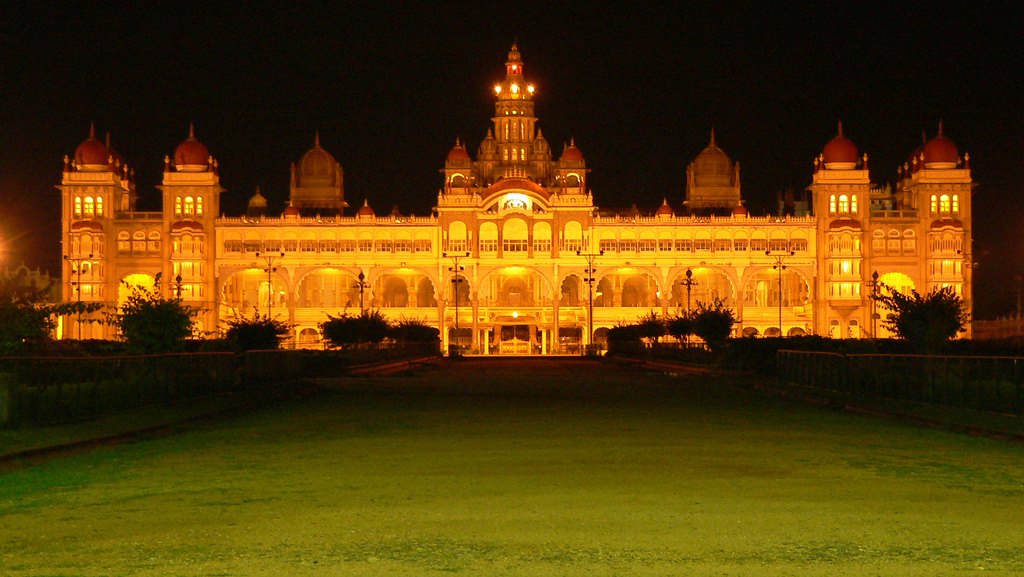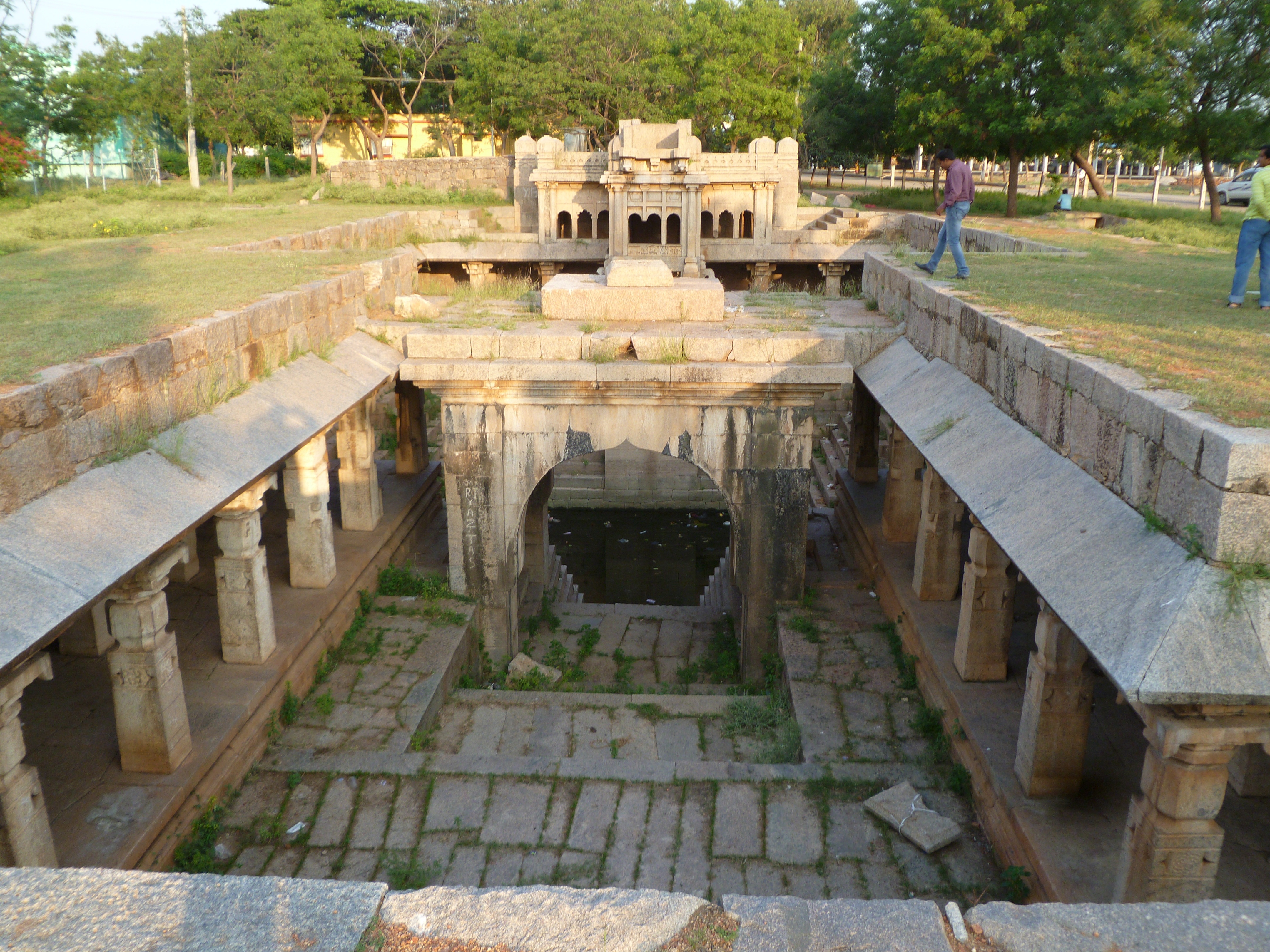|
Gangavati, Karnataka
Gangavati is a city, municipality and taluk in the Koppal district of the Indian state of Karnataka. It is one of the main commercial hubs in the Kalyana-Karnataka region. It is also the largest city, in terms of area and population, in the Koppal district. Geography Gangavathi lies at an average elevation of , and is situated close to the Tungabhadra Dam. It is a taluka (administrative division) of Koppal, a district that was previously part of Raichur. Within Gangavathi Taluk are thirty-eight gram panchayats, or self-governing villages. Economy Gangavathi is a commercial center and a major focal point for the Rice Milling industry, with its rural areas being important for Paddy cultivation. Gangavati has Asia's first Rice Technology Park. Demographics According to the 2011 India census, Gangavathi had a population of 1,05,529. Males constituted 51% of the population and females 49%. Gangavathi had an average literacy rate of 57%, lower than the national average of 59.5%: ... [...More Info...] [...Related Items...] OR: [Wikipedia] [Google] [Baidu] |
WikiProject Indian Cities
A WikiProject, or Wikiproject, is a Wikimedia movement affinity group for contributors with shared goals. WikiProjects are prevalent within the largest wiki, Wikipedia, and exist to varying degrees within sister projects such as Wiktionary, Wikiquote, Wikidata, and Wikisource. They also exist in different languages, and translation of articles is a form of their collaboration. During the COVID-19 pandemic, CBS News noted the role of Wikipedia's WikiProject Medicine in maintaining the accuracy of articles related to the disease. Another WikiProject that has drawn attention is WikiProject Women Scientists, which was profiled by '' Smithsonian'' for its efforts to improve coverage of women scientists which the profile noted had "helped increase the number of female scientists on Wikipedia from around 1,600 to over 5,000". On Wikipedia Some Wikipedia WikiProjects are substantial enough to engage in cooperative activities with outside organizations relevant to the field at issue. For ex ... [...More Info...] [...Related Items...] OR: [Wikipedia] [Google] [Baidu] |
Rice Huller
A rice huller or rice husker is an agricultural machine used to automate the process of removing the chaff (the outer husks) of grains of rice. Throughout history, there have been numerous techniques to hull rice. Traditionally, it would be pounded using some form of mortar and pestle. An early simple machine to do this is a rice pounder. Later even more efficient machinery was developed to hull and polish rice. These machines are most widely developed and used throughout Asia where the most popular type is the Engelberg huller designed by German Brazilian engineer Evaristo Conrado Engelberg in Brazil and first patented in 1885. The Engelberg huller uses steel rollers to remove the husk. Other types of huller include the disk or ''cono'' huller which uses an abrasive rotating disk to first remove the husk before passing the grain to conical rollers which polish it to make white rice; this is done repeatedly since other sides of circular side of rice are not husked. Rubber rol ... [...More Info...] [...Related Items...] OR: [Wikipedia] [Google] [Baidu] |
Siddapur, Koppala
Siddapur is a village in Koppal district, Karnataka Karnataka (; ISO: , , also known as Karunāḍu) is a state in the southwestern region of India. It was formed on 1 November 1956, with the passage of the States Reorganisation Act. Originally known as Mysore State , it was renamed ''Karnat ..., India to the northeast of Gangawati town. It is located at 15.530, 76.636. Gallery File:SiddapurKoppalBusStop.jpg, Bus Terminal File:SiddapurKoppalSharanaBasaveshwaraJatra1.jpg, Sri. Sharana Basaveshwara Theru File:SriVeerappayyaThathaRealPic.jpg, ಶ್ರೀ ವೀರಪ್ಪಯ್ಯತಾತಾ ನವರ ಭಾವಚಿತ್ರ File:SriViruppayyaThathaPic.jpg, ಶ್ರೀ ವೀರಪ್ಪಯ್ಯತಾತಾ ನವರ ಮೂರ್ತಿ References Villages in Koppal district {{Koppal-geo-stub ... [...More Info...] [...Related Items...] OR: [Wikipedia] [Google] [Baidu] |
Akalkumpi, Koppal
Akalkumpi, Gangawati is a village in the southern state of Karnataka, India. , Census Village code= 595300 Akalkumpi, Gangawati, Koppal, Karnataka It is located in the Gangawati taluk of Koppal district in Karnataka. See also * Koppal * Districts of Karnataka The Indian State of Karnataka consists of 31 districts grouped into 4 administrative divisions. The state geographically has 3 principal regions: the coastal region of Karavali, the hilly Malenadu region comprising the Western Ghats, and the ... References External links * https://web.archive.org/web/20190810051205/https://koppal.nic.in/ Villages in Koppal district {{Koppal-geo-stub ... [...More Info...] [...Related Items...] OR: [Wikipedia] [Google] [Baidu] |
Mysore Dasara
Mysore Dasara is the ''Nadahabba'' (state festival) of the state of Karnataka in India. It is a 10-day festival, starting with nine nights called Navaratri and the last day being Vijayadashami. The festival is observed on the tenth day in the Hindu calendar month of ''Ashvina'', which typically falls in the Gregorian months of September and October. The Hindu festival of Dasara, Navratri and Vijayadashami celebrates the victory of good over evil. It was the day in the Hindu legends when Goddess Durga, Chamundeshwari (Durga) killed the demon Mahishasura. Mahishasura is the demon whose slaying by the Goddess gave the city the name Mysuru. The Mysuru tradition celebrates the warriors and the state fighting for the good during this festival, ritually worshipping and displaying the state sword, weapons, elephants, horses along with Hindu Devi goddess in her warrior form (predominantly) as well as the Vishnu avatar Rama. The ceremonies and a major procession is traditionally presided ... [...More Info...] [...Related Items...] OR: [Wikipedia] [Google] [Baidu] |
Hemagudda
Hemagudda near Kammatadurga is a village in the Gangavathi taluk of Koppal district in the Indian state of Karnataka. Hemagudda is located northeast to District Headquarters Koppal. Hemagudda is from Gangavathi and from. Importance Hemagudda is noted for the 14th-century Hemagudda Fort and the Dasara Festival. , ''Deccan Herald'' See also * *Munirabad
Munirabad, also called Huligi, is a Town in the Koppal district in the Indian state of Karnataka.
Demographics
According to the 2001 Indian census, Munirabad had a populat ...
[...More Info...] [...Related Items...] OR: [Wikipedia] [Google] [Baidu] |
Nava Brindavana
Nava Brindavana (also known as Navavrundhaavana); (Kannada:ನವ ಬೃಂದಾವನ), is located on an island in the Tungabhadra River at Anegundi, near Hampi, Karnataka, India. The Brindavanas of nine Hindu Madhva saints present in Nava Brindavana belongs to the Uttaradi Math, Vyasaraja Math and Raghavendra Math . All these saints are descended from Padmanabha Tirtha, direct disciple of Jagadguru Madhvacharya. List of Saints in Nava Brindavana The nine saints in Nava Brindavana are as follows: # Padmanabha Tirtha, # Kavindra Tirtha # Vagishatirtha # Vyasatirtha # Srinivasa Tirtha # Ramatirtha # Raghuvarya Tirtha, # Sudhindra Tirtha, # Govinda Wodeyar There are also shrines to Lord Ranganatha and Lord Hanuman inside the premises. History Nava Brindavana is located in Angundi which was earlier part of Kishkindha, a mythological kingdom ruled by Sugriva. In Ramayana, when Raama and Lakshmana were in search of Seeta, Raama pointed out an island (called 'Navabrundhaavana' ... [...More Info...] [...Related Items...] OR: [Wikipedia] [Google] [Baidu] |
Anegundi
Anegundi previously called Kishkindha is a village in the Gangavathi taluk, Koppal district in the Indian state of Karnataka, It is older than Hampi, situated on the northern bank of the Tungabhadra River. Huchappayana matha temple (with black-stone pillars and dance sculptures), Pampa Sarovar, Aramane (a ruined palace), Ranganatha temple, Kamal Mahal, and Nava Brindavana are the major attractions. Nimvapuram, a nearby village, has a mount of ash believed to be the cremated remains of monkey king Vaali. Anegundi is best visited along with Hampi, it is part of the world Heritage Site, Hampi, being developed into a world class tourism spot by engaging the locals to sensitise them to their cultural wealth and provide them a means of livelihood. Existing tanks in the village have been redesigned to store clean drinking water and proper drainage facilities developed to keep the surroundings clean and hygienic. The ''Kishkinda Trust'' is working on tourism development in Anegundi. ... [...More Info...] [...Related Items...] OR: [Wikipedia] [Google] [Baidu] |
Kanakagiri
Kanakagiri (also known as Suvarnagiri) is a town in Karnataka state of India. It was a provincial capital of the Mauryan Empire and later became the capital of the Nayaka dynasty who were the Palegars (feudatory) of the Vijayanagara Empire. It is also the site of the historical site Kanakachalapathi Temple (''Kanakachalapathi Mandir'') which was built by the Nayakas. Geography Kanakagiri is situated in Koppal district, 20 km northwest of the town of Gangavati in the Indian state of Karnataka. Temple Kanakachalapathi temple was built by the Nayakas of Kanakgiri. Its halls and pillars are a unique example of south Indian architecture from the Vijayanagara period. The '' gopuras'' and walls are adorned with sculptures, including statues of Rajas and Ranis in black polished stone, plaster models, and wooden statues of mythological figures. Kanakagiri Jain tirth is a complex of Jain temple built by Western Ganga Dynasty in the 5th or 6th century. A royal bath construc ... [...More Info...] [...Related Items...] OR: [Wikipedia] [Google] [Baidu] |
Virupaksha Temple, Hampi
Virupaksha Temple () is located in Hampi in the Vijayanagara district of Karnataka, India. It is part of the Group of Monuments at Hampi, designated as a UNESCO World Heritage Site. The temple is dedicated to Lord Virupaksha, a form of Shiva. The temple was built by Lakkan Dandesha, a nayaka (chieftain) under the ruler Deva Raya II also known as Prauda Deva Raya of the Vijayanagar Empire. Hampi, capital of the Vijayanagar empire, sits on the banks of the Tungabhadra River (Pampa hole/Pampa river). Virupaksha Temple is the main center of pilgrimage (ತೀರ್ಥಯಾತ್ರೆ )at Hampi, and had been considered the most sacred sanctuary over the centuries. It is intact among the surrounding ruins and is still used in worship . The temple is dedicated to Lord Shiva, known here as Virupaksha/Pampa pathi, as the consort of the local goddess Pampadevi who is associated with the Tungabhadra River. There is also a Virupakshini Amma temple (mother goddess) in a village calle ... [...More Info...] [...Related Items...] OR: [Wikipedia] [Google] [Baidu] |
UNESCO World Heritage Site
A World Heritage Site is a landmark or area with legal protection by an international convention administered by the United Nations Educational, Scientific and Cultural Organization (UNESCO). World Heritage Sites are designated by UNESCO for having cultural, historical, scientific or other form of significance. The sites are judged to contain " cultural and natural heritage around the world considered to be of outstanding value to humanity". To be selected, a World Heritage Site must be a somehow unique landmark which is geographically and historically identifiable and has special cultural or physical significance. For example, World Heritage Sites might be ancient ruins or historical structures, buildings, cities, deserts, forests, islands, lakes, monuments, mountains, or wilderness areas. A World Heritage Site may signify a remarkable accomplishment of humanity, and serve as evidence of our intellectual history on the planet, or it might be a place of great natural beauty. A ... [...More Info...] [...Related Items...] OR: [Wikipedia] [Google] [Baidu] |




